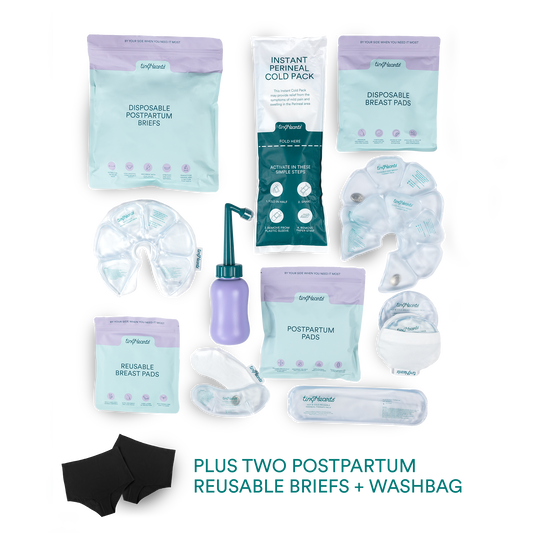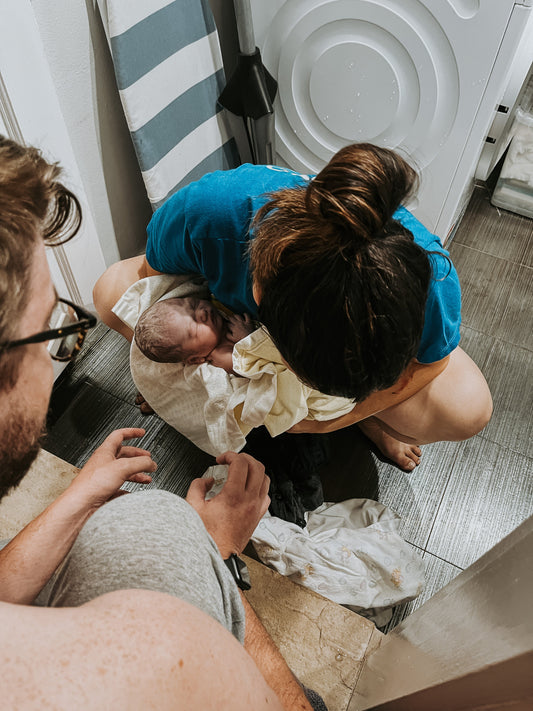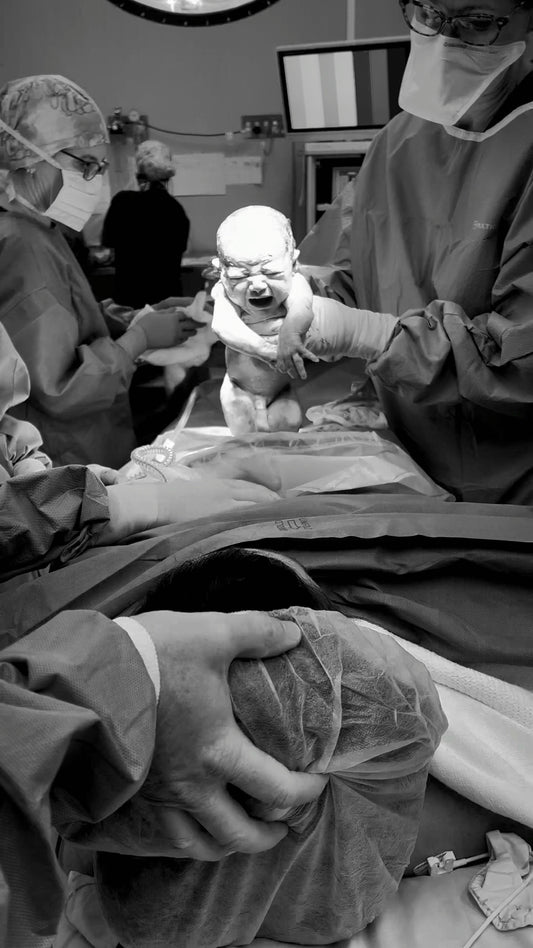A Must Read Before Birth: Postpartum Haemorrhages
Written by Jade | Midwife, Mama of 3 & Tiny Hearts Educator
Everything you need to know about postpartum haemorrhages. 🩸
A study in 2009 found that around approx 7 in every 100 mamas will have a postpartum haemorrhage [PPH], but other research suggests that these rates may be increasing in more recent times. Other sources report that it's even more common than this, with up to 1 in 10 mamas experiencing a postpartum haemorrhage. Postpartum haemorrhages can be really confronting and terrifying, which is why we've written this guide in the hopes that it arms you with the info you need to understand what's happening + what to expect during a postpartum haemorrhage.
what is a postpartum haemorrhage?
Blood loss after birth, which is called 'lochia', is completely normal and expected. After birth, you can expect to lose up to 500mls of blood as this is still considered normal. The definition of a postpartum haemorrhage varies slightly from state to state in Australia for c-sections but remains the same for vaginal births. If you lose more than this in a vaginal birth, it's classed as a 'postpartum haemorrhage'. In some states, if you lose more than 500ml during a c-section, it's also classified as PPH, while other states don't classify a PPH during a c-section until the blood loss reaches over 1000ml [1L].
where does the bleeding come from?
There are 4 sources of bleeding that can occur after birth that may be responsible for the PPH known as the 4 T's; tone, trauma, tissue, and thrombin.
Tone
When your placenta comes away from your uterus after birth, the blood vessels that supplied blood to the placenta are still open, causing them to bleed until your uterus contracts down. If the uterus isn't contracting down on itself and becomes a bit floppy, these vessels aren't contracted as well as they should be, meaning they will bleed, and the uterus could begin to collect blood, or it may gush or trickle out constantly. 'Tone' is thought to be responsible for up to 70% of all PPH's worldwide.
trauma
For vaginal births, blood may also come from vaginal or cervical tearing, an episiotomy or a haematoma [bleeding into hidden tissue or space, usually in the vaginal or vulval area, which are extremely painful]. In some cases, a blood vessel may be in the area where the tear occurred, which can increase bleeding quickly.
tissue
Tissue' links back to the 'tone' point. If there is part of the placenta or membranes still left in the uterus, it can't clamp down on itself as much as it needs to and can become floppy. This one links back to the 'tone' point. If the uterus is becoming floppy, it will bleed as the blood vessels in the uterus aren't clamped off.
thrombin
This one is usually less likely than the other three and may be in part caused by some conditions such as HELLP syndrome. It refers to a problem with the clotting factors in a mama's blood, causing delayed or reduced ability to clot the blood to stop the bleeding.
How do the healthcare team stop the bleeding?
Let's look at this using the 4 T's again.
tone
If tone is thought to be the problem, or your birthing team aren't sure, they'll usually start here. This involves rubbing the top of your uterus [called the Fundus] to make sure it feels hard + contracted, similar to a cricket ball, is in the centre of your tummy and is at or just below your belly button. If it's thought to not have good tone, is deviated to either side or feels really high, the Doctor or Midwife may request to rub it to encourage it to contract. Doing this can also expel any blood clots that are sitting inside the uterus, preventing it from contracting down really well. But it's also important to know that this can be very uncomfortable, sometimes painful, particularly if the bleeding is ongoing and the fundus needs to be rubbed multiple times. The birthing team will also recommend giving various drugs to try and force the uterus to contract to stop and prevent further bleeding. If all of these methods and medications don't work, there are other things Midwives or Doctors can do to help, such as 'bi-manual compressions' while moving quickly to theatre, where Doctors will work to further assess and control the bleeding.
trauma
If trauma is the problem, the Doctors and/or Midwives will work quickly to find where the bleeding is coming from. If it's from an easily fixable or simple tear or a single blood vessel that is bleeding, the team will either repair the tear on the spot, or apply a clamp to the vessel to stop it from bleeding. If the tear is more complex or higher up, such as on the cervix, a mama may be recommended to go to theatre for the repair.
tissue
If tone is suspected, or the reason is still unknown, the Midwives will check the placenta to see if there is a piece of it, or the membranes, that are missing and could still be stuck inside a mama's uterus. Sometimes it can be tricky to distinguish if there is some missing or not, so a Doctor may recommend a quick bedside ultrasound to see if they can see any tissue still in the uterus. If there are some suspicions that there is some tissue left behind, a mama may be recommended to be taken to theatre to double check, or empty the uterus.
thrombin
If thrombin is the cause, there are blood products or medications the birthing team may recommend to try and reverse the problem.
In all of these situations, this is an emergency, so you might hear the emergency bell and there will probably be a lot of people in the room trying to help. The team may also recommend inserting 2 cannulas and sending blood to send to pathology, which will also be needed in case the bleeding doesn't stop, and a mama has to go to theatre. Once the cannulas are in, the team may recommend starting some fluids to try to replace the blood volume that was lost, as well as inserting a catheter [tube that goes into the bladder] to empty the bladder. That's because if the bladder is full, it can prevent the uterus from contracting down as well as it should. While all of this is happening, someone will be writing down what's going on, while others may be taking your blood pressure, temp, etc. and getting you ready to go to theatre in case the bleeding doesn't stop.
so, what's normal bleeding?
- Bright red blood during the first few days after birth
- Soaking up to [but not more than] one pad an hour during the first day
- Soaking up to one pad every two hours after the first day
- Losing less blood gradually, which will change from red to pink to brown
- Blood loss to stop around four to six weeks after birth
- Temporary heavier bleeding while breastfeeding, after getting up in the morning or while exercising
- Passing small clots
now we've covered normal, what's not normal?
- Soaking more than one pad an hour during the first day
- Soaking more than one pad every two hours after the first day
- Bleeding increases suddenly or you pass large clots [keep them to show a midwife who will check it's not part of the placenta]
- Bleeding returns to bright red after changing to pink or brown
- You feel faint, dizzy, light-headed, weak or have trouble breathing
- Your bleeding smells or is an unusual colour
- You are worried you are bleeding too much or that it isn't normal
primary vs secondary pph
A primary PPH is a postpartum haemorrhage that occurs within the first 24 hours after birth, while a secondary PPH occurs between 24 hours after birth up to 12 weeks postpartum. If a secondary PPH occurs, it may be caused by some of the placenta or membranes still stuck in the uterus, an infection in the uterus or the uterus not contracting down as well as normal. If you're at home and notice a sudden increase in your bleeding, you should empty your bladder, rub the top of your fundus and breastfeed bub to see if it slows down. If the bleeding doesn't settle or is gushing, call an ambulance.
I hope this helps you understand postpartum haemorrhages and blood loss after birth. If you've got any questions, leave them in the comment section in the original post. Otherwise, tag your birthing partner + let me know your experience having a PPH.🤍
bump, birth and beyond
$350
The Bump, Birth & Beyond course will educate you and your co-pilot (support person) on what to expect during pregnancy, birth and the first trimester with your new little love.









